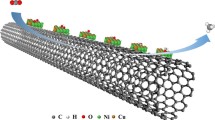Abstract
A facile design of Pt nanostructures from submonolayer to monolayer has been realized by ion adsorption-in situ electrochemical reduction on Au nanoparticles supported on multiwall carbon nanotubes (CNTs). The as prepared Au@Pt/CNTs catalysts display coverage-specific electrocatalysis. Au@Pt/CNTs with low Pt coverage is inactive towards methanol oxidation whereas it oxidizes formic acid effectively through a direct pathway with mass specific activity 90 times that of a commercial Pt/C catalyst. Due to its inertness to methanol, it shows high performance in the oxygen reduction reaction (ORR) with high methanol tolerance. In contrast, simply increasing the Pt coverage to above 40% switches the formic acid oxidation process to both direct and indirect catalytic pathways, and also results in high methanol oxidation activity.

Similar content being viewed by others
References
Steele, B. C.; Heinzel, A. Materials for fuel-cell technologies. Nature 2001, 414, 345–352.
Ji, X.; Lee, K. T.; Holden, R.; Zhang, L.; Zhang, J.; Botton, G. A.; Couillard, M.; Nazar, L. F. Nanocrystalline intermetallics on mesoporous carbon for direct formic acid fuel cell anodes. Nat. Chem. 2010, 2, 286–293.
Esposito, D. V.; Chen, J. G. Monolayer platinum supported on tungsten carbides as low-cost electrocatalysts: Opportunities and limitations. Energy Environ. Sci. 2011, 4, 3900–3912.
Sarkar, A.; Manthiram, A. Synthesis of Pt@Cu core-shell nanoparticles by galvanic displacement of Cu by Pt4+ ions and their application as electrocatalysts for oxygen reduction reaction in fuel cells. J. Phys. Chem. C 2010, 114, 4725–4732.
Sasaki, K.; Naohara, H.; Cai, Y.; Choi, Y. M.; Liu, P.; Vukmirovic, M. B.; Wang, J. X.; Adzic, R. R. Core-protected platinum monolayer shell high-stability electrocatalysts for fuel-cell cathodes. Angew. Chem., Int. Ed. 2010, 49, 8602–8607.
Jin, Y.; Shen, Y.; Dong, S. Electrochemical design of ultrathin platinum-coated gold nanoparticle monolayer films as a novel nanostructured electrocatalyst for oxygen reduction. J. Phys. Chem. B 2004, 108, 8142–8147.
Cheng, S.; Rettew, R. E.; Sauerbrey, M.; Alamgir, F. M. Architecture-dependent surface chemistry for Pt monolayers on carbon-supported Au. ACS Appl. Mater. Interfaces 2011, 3, 3948–3956.
Brankovic, S. R.; Wang, J. X.; Adžić, R. R. Metal monolayer deposition by metal adlayers on electrode surface. Surf. Sci. 2001, 474, L173–L179.
Zhang, J.; Mo, Y.; Vukmirovic, M. B.; Klie, R.; Sasaki, K.; Adžić, R. R. Platinum monolayer electrocatalysts for O2 reduction: Pt monolayer on Pd(111) and on carbon-supported Pd nanoparticles. J. Phys. Chem. B 2004, 108, 10955–10964.
Inoue, H.; Brankovic, S. R.; Wang, J. X.; Adžić, R. R. Oxygen reduction on bare and Pt monolayer-modified Ru(0001), Ru(101\(\bar 1\)0) and Ru nanostructured surfaces. Electrochim. Acta 2002, 47, 3777–3785.
Sasaki, K.; Zhang, J.; Wang, J.; Uribe, F.; Adžić, R. R. Platinum submonolayer-monolayer electrocatalysts: An electrochemical and X-ray absorption spectroscopy study. Res. Chem. Intermediat. 2006, 32, 543–559.
Sasaki, K.; Mo, Y.; Wang, J. X.; Balasubramanian, M.; Uribe, F.; McBreen, J.; Adžić, R. R. Pt submonolayers on metal nanoparticles-Novel electrocatalysts for H2 oxidation and O2 reduction. Electrochim. Acta 2003, 48, 3841–3849.
Brankovic, S. R.; Wang, J. X.; Adžić, R. R. Pt submonolayers on Ru nanoparticles: A novel low Pt loading, high CO tolerance fuel cell electrocatalyst. Electrochem. Solid-State Lett. 2001, 4, A217–A220.
Esposito, D. V.; Hunt, S. T.; Kimmel, Y. C.; Chen, J. G. A new class of electrocatalysts for hydrogen production from water electrolysis: Metal monolayers supported on low-cost transition metal carbides. J. Am. Chem. Soc. 2012, 134, 3025–3033.
Nagahara, Y.; Hara, M.; Yoshimoto, S.; Inukai, J.; Yau, S. L.; Itaya, K. In situ scanning tunneling microscopy examination of molecular adlayers of haloplatinate complexes and electrochemically produced platinum nanoparticles on Au(111). J. Phys. Chem. B 2004, 108, 3224–3230.
Kristian, N.; Yu, Y.; Gunawan, P.; Xu, R.; Deng, W.; Liu, X.; Wang, X. Controlled synthesis of Pt-decorated Au nanostructure and its promoted activity toward formic acid electro-oxidation. Electrochim. Acta 2009, 54, 4916–4924.
Hamelin, A. Cyclic voltammetry at gold single-crystal surfaces. J. Electroanal. Chem. 1996, 407, 1–21.
Trasatti, S.; Petrii, O. A. Real surface area measurements in electrochemistry. Pure Appl. Chem. 1991, 63, 711–734.
Kim, S.; Jung, C.; Kim, J.; Rhee, C. K.; Choi, S.-M.; Lim, T. H. Modification of Au nanoparticles dispersed on carbon support using spontaneous deposition of Pt toward formic acid oxidation. Langmuir 2010, 26, 4497–4505.
Zhang, S.; Shao, Y.; Yin, G.; Lin, Y. Electrostatic self-assembly of a Pt-around-Au nanocomposite with high activity towards formic acid oxidation. Angew. Chem., Int. Ed. 2010, 49, 2211–2214.
Capon, A.; Parsons, R. The oxidation of formic acid at noble metal electrodes Part III. Intermediates and mechanism on platinum electrodes. J. Electroanal. Chem. Interfacial Electrochem. 1973, 45, 205–231.
Wolter, O.; Willsau, J.; Heitbaum, J. Reaction pathways of the anodic oxidation of formic acid on Pt evidenced by 18O labeling—A DEMS study. J. Electrochem. Soc. 1985, 132, 1635–1638.
Sun, S. G.; Clavilier, J.; Bewick, A. The mechanism of electrocatalytic oxidation of formic acid on Pt(100) and Pt(111) in sulphuric acid solution: An emirs study. J. Electroanal. Chem. Interfacial Electrochem. 1988, 240, 147–159.
Kristian, N.; Yan, Y.; Wang, X. Highly efficient submonolayer Pt-decorated Au nano-catalysts for formic acid oxidation. Chem. Commun. 2008, 353–355.
Wang, R.; Wang, C.; Cai, W. B.; Ding, Y. Ultralow-platinum-loading high-performance nanoporous electrocatalysts with nanoengineered surface structure. Adv. Mater. 2010, 22, 1845–1848.
Neurock, M.; Janik, M.; Wieckowski, A. A first principles comparison of the mechanism and site requirements for the electrocatalytic oxidation of methanol and formic acid over Pt. Faraday Discuss. 2009, 140, 363–378.
Author information
Authors and Affiliations
Corresponding authors
Electronic supplementary material
Rights and permissions
About this article
Cite this article
Zheng, F., Wong, WT. & Yung, KF. Facile design of Au@Pt core-shell nanostructures: Formation of Pt submonolayers with tunable coverage and their applications in electrocatalysis. Nano Res. 7, 410–417 (2014). https://doi.org/10.1007/s12274-014-0407-1
Received:
Revised:
Accepted:
Published:
Issue Date:
DOI: https://doi.org/10.1007/s12274-014-0407-1




